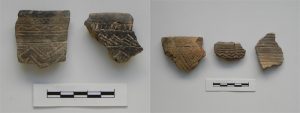Spain’s first Bell Beaker culture’s earthwork enclosure was discovered by archaeologists. The structure, composed of concentric rings of earthwork is dated to 2600-2200 BC. Archaeologists suspect it might have been used for holding rituals. Such structures have previously only been found in northern Europe, North of the Alps.

Archaeologists from the Tübingen collaborative research centre ResourceCultures discovered the earthwork enclosure some 50 kilometres east of Valencina de la Concepción, which was Spain’s largest known Copper Age settlement, encompassing over 400 hectares. The circular earthworks enclosing about six hectares. Excavations at the site yielded bones, sherds and jewellery. Radiocarbon dating and comparative analysis confirmed the site was used during the Bell Beaker Culture (ca. 2600 to 2200 BC).

The site consists of several circular trenches with entrance-like openings at regular intervals. In the centre was a deep, circular hole some 19 meters wide inside which clay bricks with burn marks were found. No human remains or indications of continuous settlement after the Copper Age were found, indicating that he site was used intensively for a relatively short period.

Grave goods, such as exotic luxury wares made from elephant tusks from Africa and the Middle East, and amber beads from northern Europe, found at the site show that the people of Valencina traded with Copper Age cultures far away. In return they possibly traded copper ore from the mountains nearby Valencina.
(after Past Horizons)